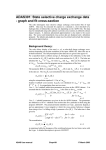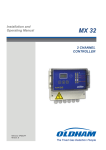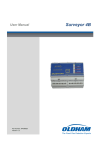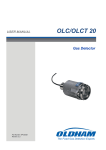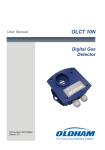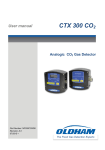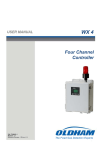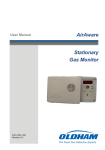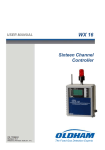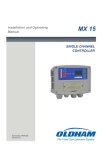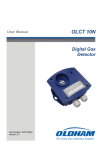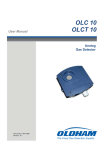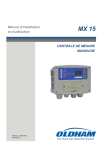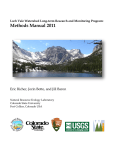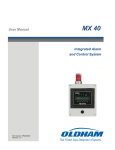Download OLCT200 HART Specification_rev 02.1_EN (77036008)
Transcript
HART® Field Device Specification: Oldham OLCT 200 Revision 1 Initial release: 13 April 2011 Current release: 13 April 2011 Part Number: 77036008 Revision: 02.1 ® HART is a registered trademark of the HART Communication Foundation This page left intentionally blank Revision 1.0, Release Date: April 13, 2011 Page 2 of 20 TABLE OF CONTENTS 1. Introduction ................................................................................................................. 5 1.1 1.2 1.3 1.4 1.5 Scope .................................................................................................................... 5 Purpose ................................................................................................................. 5 Who should use this document? ........................................................................... 5 Abbreviations and definitions .............................................................................. 5 References ............................................................................................................ 5 2. Device Identification ................................................................................................... 6 3. Product Overview ....................................................................................................... 6 4. Product Interfaces ....................................................................................................... 6 4.1 Process Interface .................................................................................................. 6 4.1.1 Sensor Input Channels .................................................................................. 6 4.2 Host interface ....................................................................................................... 6 4.2.1 Analog Output 1: Gas Concentration ............................................................ 6 4.3 Local Interfaces, Jumpers and Switches .............................................................. 7 4.3.1 Local Controls And Displays ........................................................................ 7 4.3.2 Internal Jumpers And Switches .................................................................... 7 5. Device Variables ......................................................................................................... 7 6. Dynamic Variables...................................................................................................... 7 7. Status Information ....................................................................................................... 8 7.1 7.2 7.3 Device Status ........................................................................................................ 8 Extended Device Status ........................................................................................ 8 Additional Device Status (Command #48) .......................................................... 8 8. Universal Commands .................................................................................................. 9 9. Common-Practice Commands .................................................................................... 9 9.1 9.2 9.3 Supported Commands .......................................................................................... 9 Burst Mode ........................................................................................................... 9 Catch Device Variable ......................................................................................... 9 10. Device-Specific Commands...................................................................................... 10 10.1 10.2 10.3 10.4 Command #128: Read Firmware .................................................................... 10 Command #129: Read Active Channel .......................................................... 11 Command #130: Read Sensor Life ................................................................. 11 Command #131: Read Engineering Units ...................................................... 12 Revision 1.0, Release Date: April 13, 2011 Page 3 of 20 10.5 10.6 10.7 10.8 10.9 10.10 10.11 10.12 Command #132: Read Unit Identifier ............................................................ 12 Command #133: Read Enumerated Variables................................................ 13 Command #134: Read Real Variables............................................................ 13 Command #141: Write Engineering Units ..................................................... 14 Command #142: Write Unit Identifier ........................................................... 14 Command #143: Write Enumerated Variables ............................................... 15 Command #144: Write Read Variables .......................................................... 16 Command #150: Reset Communications Lost ............................................... 16 11. Tables ........................................................................................................................ 17 12. Performance .............................................................................................................. 17 12.1 12.2 12.3 12.4 12.5 12.6 12.7 12.8 12.9 12.10 12.11 Sampling Rates ............................................................................................... 17 Power-Up ........................................................................................................ 17 Reset ............................................................................................................... 17 Self-Test.......................................................................................................... 17 Command Response Times ............................................................................ 17 Busy and Delayed Response........................................................................... 18 Long Messages ............................................................................................... 18 Non-Volatile Memory .................................................................................... 18 Modes ............................................................................................................. 18 Write Protect ................................................................................................... 18 Damping ......................................................................................................... 18 Annex A. Capability Checklist ....................................................................................... 19 Revision 1.0, Release Date: April 13, 2011 Page 4 of 20 1. INTRODUCTION 1.1 Scope The Oldham S.A.S gas detection transmitter, model OLCT 200, revision 1 complies with HART Protocol Revision 7.2. This document specifies all the device specific features and documents HART Protocol implementation details (e.g., the Engineering Unit Codes supported). The functionality of this Field Device is described sufficiently to allow its proper application in a process and its complete support in HART capable Host Applications. 1.2 Purpose This specification is designed to compliment other documentation (e.g., the OLCT 200 User Manual) by providing a complete, unambiguous description of this Field Device from a HART Communication perspective 1.3 Who should use this document? This specification is designed to be a technical reference for HART capable Host Application Developers, System Integrators and knowledgeable End Users. It also provides functional specifications (e.g., commands, enumerations and performance requirements) used during Field Device development, maintenance and testing. This document assumes the reader is familiar with HART Protocol requirements and terminology. 1.4 Abbreviations and definitions ADC Analog to Digital Converter CPU Central Processing Unit (of microprocessor) DAC Digital to Analog Converter EEPROM Electrically-Erasable Read-Only Memory 1.5 References HART Field Communication Protocol Specification. HCF_SPEC-13. Available from the HCF. OLCT 200 User Installation Manual, Document IMAN123-2003. Available from the Oldham S.A.S. Revision 1.0, Release Date: April 13, 2011 Page 5 of 20 2. DEVICE IDENTIFICATION Manufacturer Name: Oldham S.A.S Manufacture ID Code: 604D HART Protocol Revision: 7.2 (Hex) Model Name(s): OLCT 200 Device Type Code: E198 Device Revision: 1 (Hex) Number of Device Variables: 1 Physical Layers Supported: FSK Physical Device Category: Transmitter, Non-DC-isolated Bus Device The product’s nameplate including serial number can be seen on the metal tag on the top of the unit. 3. PRODUCT OVERVIEW The OLCT 200 is a fixed placement gas detection transmitter intended to monitor for hazardous levels of toxic gases, oxygen, and combustible gases. The transmitter is housed in an explosion-proof enclosure and product features a LCD screen to display gas readings and provide access to the transmitter’s menu functions. The device provides both analog 4-20mA and digital ModBus RTU communication and is externally powered by 10-30VDC. 4. PRODUCT INTERFACES 4.1 Process Interface 4.1.1 Sensor Input Channels Smart gas sensors connect to the transmitter device via standard ten pin connectors. Refer to the Installation Manual for installation details. Operating ranges correspond to the capabilities of each sensor type. 4.2 Host interface 4.2.1 Analog Output 1: Gas Concentration The two-wire, 4-to-20mA current loop is connected on two terminals marked "+" and "-" on the HART Modem board (P/N 10-0351). Refer to the Installation Manual for connection details. This is the only output from this transmitter, representing the process gas measurement, linearized and scaled according to the configured range of the instrument. This output corresponds to the Primary Variable. HART Communication is supported on this loop. This device has a CN number of 1. A guaranteed linear overrange is provided. Device malfunction can be indicated by down-scale or up-scale current. When a device malfunction occurs the loop current is set to 1mA. The direction is selectable by the user; see Section 4.3 below. Current values are shown in the table below. Revision 1.0, Release Date: April 13, 2011 Page 6 of 20 Direction Linear over-range Device malfunction indication Values (percent of range) Values (mA or V) Down -6.25% 1.0% 3.0mA 0.1mA Up +5.0% 1.0% 20.8mA 0.1mA Down: less than -19% 1.0mA Up: greater than N/A N/A +112.5% 22.0mA Maximum current Multi-Drop current draw 4.0mA Lift-off voltage 10.5 V 4.3 Local Interfaces, Jumpers and Switches 4.3.1 Local Controls And Displays The OLCT 200 has an onboard LCD screen that display gas readings as well as the devices configuration menu screens. The device is operated non-intrusively using a magnetic wand to activate the devices control buttons. Calibration of the device is also performed in this manner. 4.3.2 Internal Jumpers And Switches None. 5. DEVICE VARIABLES This Field Device does not expose any Device Variables. 6. DYNAMIC VARIABLES One dynamic variable is supported Meaning PV Gas Concentration Revision 1.0, Release Date: April 13, 2011 Classification 90, Concentration Units Engineering Units (240) Page 7 of 20 7. STATUS INFORMATION 7.1 Device Status Bit 0 – PV out of limits is not used Bit 1 – Non PV out of limits is not used. Bit 2 – Analog Output Saturated is set when the loop output current is below 3.0mA or above 20.8mA. Bit 3 – PV Analog Output Fixed is set when the loop current mode is disabled. Bit 4 – More Status Available is set whenever any failure is detected. Command 48 gives details. (See Section 7.3) Bit 5 – Cold Start is set after a power cycle and reset for each type of Master separately. Bit 6 – Configuration Changed is set when a HART command modifies the transmitter configuration. Each Master will reset this bit separately by use of Command 38. Bit 7 – Device Malfunction is set if the Modbus interface between sensor and HART board malfunctions by a communications failure. It is reset when Modbus communications is re-established. 7.2 Extended Device Status The Field Device cannot predict, in advance, when the maintenance will be required. 7.3 Additional Device Status (Command #48) Command #48 returns 9 bytes of data, with the following status information: Byte Bit 0 0 1 2 3 4 6 0 1 2 3 4 5 6 7 1 2 3 4 5 6 7 8 Meaning Channel 1 Alarm 1 Channel 1 Alarm 2 Channel 1 Fault Channel 2 Alarm 1 Channel 2 Alarm 2 Channel 2 Fault Not Used Channel 1 Cal Channel 2 Cal Calibration Required DAC Span Not Calibrated DAC Zero Not Calibrated Unique Id not Set Communication Lost Byte = 0x00 Byte = 0x00 Byte = 0x00 Byte = 0x00 Byte = 0x00 Byte = 0x00 Revision 1.0, Release Date: April 13, 2011 Class Misc. Misc. Misc. Misc. Misc. Misc. Misc. Misc. Misc. Misc. Misc. Misc. Misc. Misc. Misc. Misc. Misc. Device Status Bits Set 4 4 4 4 4 4 4 4 4 4 4 4 4 4,7 4 4 4 Page 8 of 20 8. UNIVERSAL COMMANDS Command #3 returns loop current and PV for a total of 9 bytes. Command #9 responds to host commands having up to and including four device variable codes. If more than four device variable codes are received, the response is truncated to the first four device variable codes and the response code 30, Command Response Truncated, is returned. Device variable 0 is the Primary variable so the response is identical to the Primary Variable information. Command #14 returns unit code 240 and NAN value for the upper and lower sensor limits and for the minimum span since these variables are not defined. The serial number is returned as 0 since it is not used. Command #15 returns not used for the alarm code, transfer function and private label distributor. It returns 251 for the write protect code since it is not controlled by HART Communications. There is no adjustable damping value to the value 0 is returned. 9. COMMON-PRACTICE COMMANDS 9.1 Supported Commands The following common-practice commands are implemented: 38 Reset "Configuration Changed" Flag 40 Enter/Exit Fixed Current Mode 45 Trim DAC Zero 46 Trim DAC Gain 48 Read Additional Device Status 9.2 Burst Mode This Field Device does not support Burst Mode. 9.3 Catch Device Variable This Field Device does not support Catch Device Variable. Revision 1.0, Release Date: April 13, 2011 Page 9 of 20 10. DEVICE-SPECIFIC COMMANDS The following device-specific commands are implemented: 128 Read Firmware 129 Read Active Channel 130 Read Sensor Life 131 Read Engineering Units 132 Read Unit Identifier 133 Read Enumerated Variables 134 Read Real Variables 141 Write Engineering Units 142 Write Unit Identifier 143 Write Enumerated Variables 144 Write Real Variables 150 Reset Communications Lost 10.1 Command #128: Read Firmware Reads the firmware version in ASCII. Request Data Bytes Byte Format Description None Response Data Bytes Byte Format Description 0-3 Latin-1 ASCII Firmware Version Command-Specific Response Codes Code 0 Class Description Success No Command-Specific Errors Revision 1.0, Release Date: April 13, 2011 Page 10 of 20 10.2 Command #129: Read Active Channel Reads the active channel number. Request Data Bytes Byte Format Description None Response Data Bytes Byte 0 Format Description Unsigned-8 Active Channel Command-Specific Response Codes Code 0 Class Description Success No Command-Specific Errors 10.3 Command #130: Read Sensor Life Reads the sensor life remaining. Request Data Bytes Byte Format Description None Response Data Bytes Byte Format Description 0-1 Unsigned-16 Sensor Life Command-Specific Response Codes Code 0 Class Description Success No Command-Specific Errors Revision 1.0, Release Date: April 13, 2011 Page 11 of 20 10.4 Command #131: Read Engineering Units Reads the string value of the engineering units name in ASCII. Request Data Bytes Byte Format Description None Response Data Bytes Byte Format Description 0-9 Latin-1 ASCII Engineering Units Command-Specific Response Codes Code 0 Class Description Success No Command-Specific Errors 10.5 Command #132: Read Unit Identifier Reads the string value of the unit identifier name. Request Data Bytes Byte Format Description None Response Data Bytes Byte Format Description 0-15 Latin-1 ASCII Unit Identifier Command-Specific Response Codes Code 0 Class Description Success No Command-Specific Errors Revision 1.0, Release Date: April 13, 2011 Page 12 of 20 10.6 Command #133: Read Enumerated Variables Reads the enumerated variable associated with the index value. Request Data Bytes Byte 0 Format Description Unsigned-8 Enumerated Variable Index Response Data Bytes Byte 0 1 Format Description Unsigned-8 Enumerated Enumerated Variables Index Enumerated Variable Command-Specific Response Codes Code Class Description 0 Success No Command-Specific Errors 5 Miscellaneous Error Too Few Data Bytes 15 Data Entry Error Invalid Index 10.7 Command #134: Read Real Variables Reads the value of the real variable associated with the index. Request Data Bytes Byte 0 Format Description Unsigned-8 Real Variables Index Response Data Bytes Byte 0 1-4 Format Description Unsigned-8 Real Variables Index Float Real Variable Command-Specific Response Codes Code 0 5 15 Class Description Success Miscellaneous Error Data Entry Error No Command-Specific Errors Too Few Data Bytes Invalid Index Revision 1.0, Release Date: April 13, 2011 Page 13 of 20 10.8 Command #141: Write Engineering Units Writes the string value of the engineering units. Request Data Bytes Byte Format Description 0-9 Latin-1 ASCII Engineering Units Response Data Bytes Byte 0-9 Format Latin-1 ASCII Description Engineering Units Command-Specific Response Codes Code 0 5 Class Description Success Miscellaneous Error No Command-Specific Errors Too Few Data Bytes 10.9 Command #142: Write Unit Identifier Writes the string for the unit identifier. Request Data Bytes Byte Format Description 0-15 Latin-1 ASCII Unit Identifier Response Data Bytes Byte 0-15 Format Latin-1 ASCII Description Unit Identifier Command-Specific Response Codes Code 0 5 Class Description Success Miscellaneous Error No Command-Specific Errors Too Few Data Bytes Revision 1.0, Release Date: April 13, 2011 Page 14 of 20 10.10 Command #143: Write Enumerated Variables Writes the value of the enumerated variable associated with the index. Request Data Bytes Byte Format Description 0 Unsigned-8 Enumerated Variable Index 1 Enumerated Enumerated Variable Response Data Bytes Byte Format Description 0 Unsigned-8 Enumerated Variable Index 1 Enumerated Enumerated Variable Command-Specific Response Codes Code Class Description 0 Success No Command-Specific Errors 5 15 Miscellaneous Error Data Entry Error Too Few Data Bytes Invalid Index Revision 1.0, Release Date: April 13, 2011 Page 15 of 20 10.11 Command #144: Write Read Variables Writes the value of the real variable associated with the index. Request Data Bytes Byte 0 1-4 Format Description Unsigned-8 Real Variable Index Float Real Variable Response Data Bytes Byte 0 1-4 Format Description Unsigned-8 Real Variable Index Float Real Variable Command-Specific Response Codes Code Class Description 0 Success No Command-Specific Errors 5 15 Miscellaneous Error Data Entry Error Too Few Data Bytes Invalid Index 10.12 Command #150: Reset Communications Lost Resets the Communications Lost Status Bit. Request Data Bytes Byte Format Description None Response Data Bytes Byte Format Description None Command-Specific Response Codes Code 0 Class Description Success No Command-Specific Errors Revision 1.0, Release Date: April 13, 2011 Page 16 of 20 11. TABLES No applicable tables 12. PERFORMANCE 12.1 Sampling Rates The table shows the HART interface board update rates. Dynamic Variable Measured Variable Sample Rate 1 per second Analog Output 1 per second 12.2 Power-Up At power up the device goes through an initialization process that takes several seconds. Communications between the HART interface and the sensor begins about 20 seconds after power up, but the sensor may take longer to initialize the dynamic variables values. 12.3 Reset Command 42, Device Reset, is not supported in the HART Interface. 12.4 Self-Test Command 41, Self-Test, is not supported in the HART Interface. 12.5 Command Response Times Minimum 10 ms. Typical 25 ms. Maximum 100 ms. Revision 1.0, Release Date: April 13, 2011 Page 17 of 20 12.6 Busy and Delayed Response No delayed response mechanism is supported. 12.7 Long Messages The longest message response is 37 data bytes when the master requests four slot variables in issuing Command 9, Read Device Variables and Status. 12.8 Non-Volatile Memory HART configuration data is written to the EEPROM on the HART interface board during processing of the HART command. Sensor configuration data is written to the sensor through Modbus interface by the HART command. Process parameters are stored in RAM each second and read back to the host on request. 12.9 Modes Fixed current mode is attained through use of Command 40, Enter/Exit Fixed Current Mode. It is also attained through Command 6, Write Poll Address, when the Loop Current Mode parameter is set to disabled. 12.10 Write Protect No write protect is provided in the HART interface board. 12.11 Damping No additional PV damping is provided beyond the sampling of the sensor value by the HART interface board once per second. Revision 1.0, Release Date: April 13, 2011 Page 18 of 20 ANNEX A. CAPABILITY CHECKLIST Manufacturer, model and revision Oldham S.A.S, OLCT 200 Rev 1 Device type Transmitter HART revision 7.2 Device Description available Yes Number and type of sensors 25 Sensors; 4 types Number and type of actuators None Number and type of host side signals 1: 4 - 20mA Analog Number of Device Variables 0 Number of Dynamic Variables 1 Mappable Dynamic Variables? No Number of common-practice commands 3 Number of device-specific commands 12 Bits of additional device status 13 Alternative operating modes? No Burst mode? No Write-protection? No Revision 1.0, Release Date: April 13, 2011 Page 19 of 20 The Fixed Gas Detection Experts EUROPEAN PLANT AND OFFICES Z.I. Est – rue Orfila CS 20417 – 62027 Arras Cedex FRANCE Tél: +33 (0)3 21 60 80 80 – Fax: +33 (0)3 21 60 80 00 Website: http://www.oldhamgas.com AMERICAS Tel: +1-713-559-9280 Fax: +1-281-292-2860 [email protected] ASIA PACIFIC Tel: +86-21-3127-6373 Fax: +86-21-3127-6365 [email protected] EUROPE Tel: +33-321-608-080 Fax: +33-321-608-000 [email protected]




















